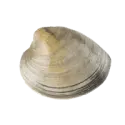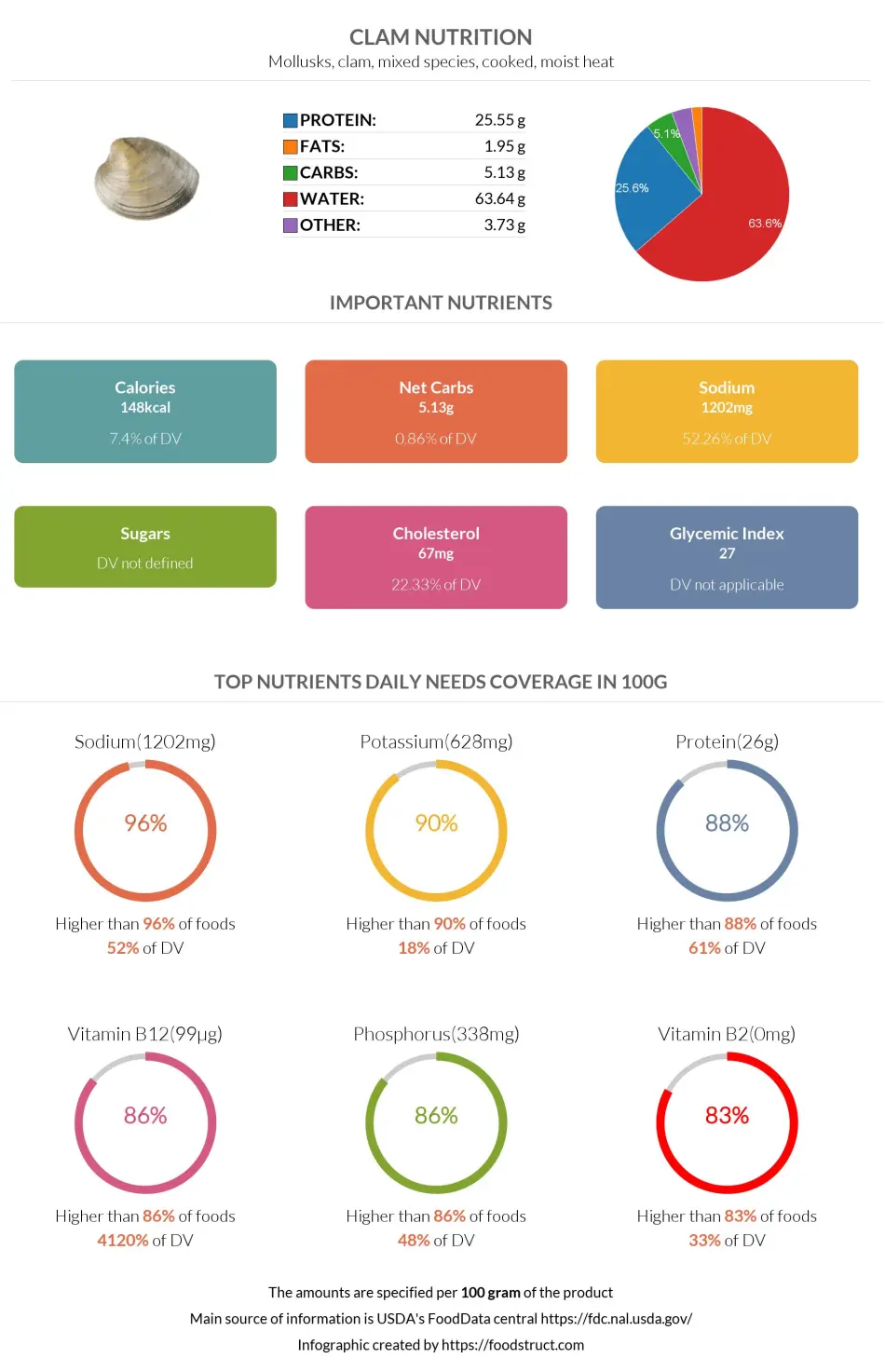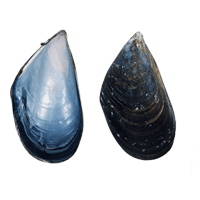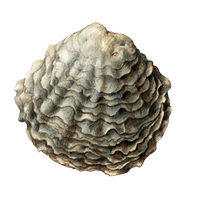Clam nutrition: calories, carbs, GI, protein, fiber, fats
Mollusks, clam, mixed species, cooked, moist heat
*all the values are displayed for the amount of 100 grams
Important nutritional characteristics for Clam

| Glycemic index ⓘ Gi values are taken from various scientific sources. GI values less than 55 are considered as low. Values above 70 are considered as high. | 27 (low) |
| Glycemic load | 1 (low) |
| Calories ⓘ Calories per 100-gram serving | 148 |
| Net Carbs ⓘ Net Carbs = Total Carbohydrates – Fiber – Sugar Alcohols | 5.13 grams |
| Serving Size ⓘ Serving sizes are taken from FDA's Reference Amounts Customarily Consumed (RACCs) | 3 oz (85 grams) |
| Acidity (Based on PRAL) ⓘ PRAL (Potential renal acid load) is calculated using a formula. On the PRAL scale the higher the positive value, the more is the acidifying effect on the body. The lower the negative value, the higher the alkalinity of the food. 0 is neutral. | 10.2 (acidic) |
| Oxalates ⓘ Animal products do not contain oxalate. | 0mg |
Sodium ⓘHigher in Sodium content than 96% of foods
Potassium ⓘHigher in Potassium content than 90% of foods
Protein ⓘHigher in Protein content than 88% of foods
Vitamin B12 ⓘHigher in Vitamin B12 content than 86% of foods
Phosphorus ⓘHigher in Phosphorus content than 86% of foods
Clam calories (kcal)
| Serving Size | Calories | Weight |
|---|---|---|
| Calories in 100 grams | 148 | |
| Calories in 3 oz | 126 | 85 g |
| Calories in 20 small | 281 | 190 g |
Clam Glycemic index (GI)
Gi values are taken from various scientific sources. GI values less than 55 are considered as low. Values above 70 are considered as high.
Clam Glycemic load (GL)
Mineral coverage chart
Calcium:
92 mg of 1,000 mg
9%
Iron:
2.81 mg of 8 mg
35%
Magnesium:
18 mg of 420 mg
4%
Phosphorus:
338 mg of 700 mg
48%
Potassium:
628 mg of 3,400 mg
18%
Sodium:
1202 mg of 2,300 mg
52%
Zinc:
2.73 mg of 11 mg
25%
Copper:
0.688 mg of 1 mg
76%
Manganese:
1 mg of 2 mg
43%
Selenium:
64 µg of 55 µg
116%
Choline:
0 mg of 550 mg
0%
Mineral chart - relative view
Sodium
1202 mg
TOP 4%
Potassium
628 mg
TOP 10%
Phosphorus
338 mg
TOP 14%
Copper
0.688 mg
TOP 18%
Selenium
64 µg
TOP 21%
Iron
2.81 mg
TOP 23%
Calcium
92 mg
TOP 24%
Manganese
1 mg
TOP 32%
Zinc
2.73 mg
TOP 32%
Magnesium
18 mg
TOP 66%
Vitamin coverage chart
Vitamin A:
570 IU of 5,000 IU
11%
Vitamin E :
0 mg of 15 mg
0%
Vitamin D:
0 µg of 10 µg
0%
Vitamin C:
22.1 mg of 90 mg
25%
Vitamin B1:
0.15 mg of 1 mg
13%
Vitamin B2:
0.426 mg of 1 mg
33%
Vitamin B3:
3.354 mg of 16 mg
21%
Vitamin B5:
0.68 mg of 5 mg
14%
Vitamin B6:
0.11 mg of 1 mg
8%
Folate:
29 µg of 400 µg
7%
Vitamin B12:
98.89 µg of 2 µg
4,120%
Vitamin K:
0 µg of 120 µg
0%
Vitamin chart - relative view
Vitamin B12
98.89 µg
TOP 14%
Vitamin B2
0.426 mg
TOP 17%
Vitamin C
22.1 mg
TOP 18%
Vitamin A
570 IU
TOP 23%
Vitamin B1
0.15 mg
TOP 39%
Folate
29 µg
TOP 42%
Vitamin B5
0.68 mg
TOP 47%
Vitamin B3
3.354 mg
TOP 48%
Vitamin B6
0.11 mg
TOP 62%
Macronutrients chart
Protein:
Daily Value: 51%
25.55 g of 50 g
51%
Fats:
Daily Value: 3%
1.95 g of 65 g
3%
Carbs:
Daily Value: 2%
5.13 g of 300 g
2%
Water:
Daily Value: 3%
63.64 g of 2,000 g
3%
Other:
3.73 g
Protein quality breakdown
Tryptophan:
286 mg of 280 mg
102%
Threonine:
1099 mg of 1,050 mg
105%
Isoleucine:
1112 mg of 1,400 mg
79%
Leucine:
1798 mg of 2,730 mg
66%
Lysine:
1909 mg of 2,100 mg
91%
Methionine:
576 mg of 1,050 mg
55%
Phenylalanine:
915 mg of 1,750 mg
52%
Valine:
1116 mg of 1,820 mg
61%
Histidine:
490 mg of 700 mg
70%
Fat type information
Saturated Fat:
0.188 g
Monounsaturated Fat:
0.172 g
Polyunsaturated fat:
0.552 g
All nutrients for Clam per 100g
| Nutrient | Value | DV% | In TOP % of foods | Comparison |
| Calories | 148kcal | 7% | 60% |
3.1 times more than Orange
|
| Protein | 25.55g | 61% | 12% |
9.1 times more than Broccoli
|
| Fats | 1.95g | 3% | 67% |
17.1 times less than Cheddar Cheese
|
| Vitamin C | 22.1mg | 25% | 18% |
2.4 times less than Lemon
|
| Net carbs | 5.13g | N/A | 56% |
10.6 times less than Chocolate
|
| Carbs | 5.13g | 2% | 60% |
5.5 times less than Rice
|
| Cholesterol | 67mg | 22% | 28% |
5.6 times less than Egg
|
| Iron | 2.81mg | 35% | 23% |
1.1 times more than Beef broiled
|
| Calcium | 92mg | 9% | 24% |
1.4 times less than Milk
|
| Potassium | 628mg | 18% | 10% |
4.3 times more than Cucumber
|
| Magnesium | 18mg | 4% | 66% |
7.8 times less than Almond
|
| Fiber | 0g | 0% | 100% |
N/A
|
| Copper | 0.69mg | 76% | 18% |
4.8 times more than Shiitake
|
| Zinc | 2.73mg | 25% | 32% |
2.3 times less than Beef broiled
|
| Phosphorus | 338mg | 48% | 14% |
1.9 times more than Chicken meat
|
| Sodium | 1202mg | 52% | 4% |
2.5 times more than White Bread
|
| Vitamin A | 570IU | 11% | 23% |
29.3 times less than Carrot
|
| Vitamin A RAE | 171µg | 19% | 26% | |
| Selenium | 64µg | 116% | 21% | |
| Manganese | 1mg | 43% | 32% | |
| Vitamin B1 | 0.15mg | 13% | 39% |
1.8 times less than Pea raw
|
| Vitamin B2 | 0.43mg | 33% | 17% |
3.3 times more than Avocado
|
| Vitamin B3 | 3.35mg | 21% | 48% |
2.9 times less than Turkey meat
|
| Vitamin B5 | 0.68mg | 14% | 47% |
1.7 times less than Sunflower seed
|
| Vitamin B6 | 0.11mg | 8% | 62% |
1.1 times less than Oat
|
| Vitamin B12 | 98.89µg | 4120% | 14% |
141.3 times more than Pork
|
| Folate | 29µg | 7% | 42% |
2.1 times less than Brussels sprout
|
| Saturated Fat | 0.19g | 1% | 77% |
31.4 times less than Beef broiled
|
| Monounsaturated Fat | 0.17g | N/A | 79% |
57 times less than Avocado
|
| Polyunsaturated fat | 0.55g | N/A | 59% |
85.5 times less than Walnut
|
| Tryptophan | 0.29mg | 0% | 52% |
1.1 times less than Chicken meat
|
| Threonine | 1.1mg | 0% | 52% |
1.5 times more than Beef broiled
|
| Isoleucine | 1.11mg | 0% | 55% |
1.2 times more than Salmon raw
|
| Leucine | 1.8mg | 0% | 57% |
1.4 times less than Tuna Bluefin
|
| Lysine | 1.91mg | 0% | 58% |
4.2 times more than Tofu
|
| Methionine | 0.58mg | 0% | 59% |
6 times more than Quinoa
|
| Phenylalanine | 0.92mg | 0% | 58% |
1.4 times more than Egg
|
| Valine | 1.12mg | 0% | 58% |
1.8 times less than Soybean raw
|
| Histidine | 0.49mg | 0% | 69% |
1.5 times less than Turkey meat
|
| Omega-3 - EPA | 0.14g | N/A | 34% |
5 times less than Salmon
|
| Omega-3 - DHA | 0.15g | N/A | 34% |
10 times less than Salmon
|
| Omega-3 - DPA | 0.1g | N/A | 33% |
1.6 times less than Salmon
|
Check out similar food or compare with current
NUTRITION FACTS LABEL
Nutrition Facts
___servings per container
Serving Size ______________
Serving Size ______________
Amount Per 100g
Calories 148
% Daily Value*
3%
Total Fat
2g
0%
Saturated Fat 0g
22%
Cholesterol 67mg
0%
Sodium 1,202mg
2%
Total Carbohydrate
5g
0%
Dietary Fiber
0g
Total Sugars g
Includes ? g Added Sugars
Protein
26g
Vitamin D
0mcg
0%
Calcium
92mg
9%
Iron
3mg
38%
Potassium
628mg
18%
*
The % Daily Value (DV) tells you how much a nutrient in a serving of food contributes to a daily diet. 2,000 calories a day is used for general nutrition advice.
Health checks
Low in Cholesterol
ⓘ
Dietary cholesterol is not associated with an increased risk of coronary heart disease in healthy individuals. However, dietary cholesterol is common in foods that are high in harmful saturated fats.
Source
No Trans Fats
ⓘ
Trans fat consumption increases the risk of cardiovascular disease and mortality by negatively affecting blood lipid levels.
Source
Low in Saturated Fats
ⓘ
Saturated fat intake can raise total cholesterol and LDL (low-density lipoprotein) levels, leading to an increased risk of atherosclerosis. Dietary guidelines recommend limiting saturated fats to under 10% of calories a day.
Source
Low in Sugars
ⓘ
While the consumption of moderate amounts of added sugars is not detrimental to health, an excessive intake can increase the risk of obesity, and therefore, diabetes.
Source
Clam nutrition infographic

Infographic link
References
All the values for which the sources are not specified explicitly are taken from FDA’s Food Central. The exact link to the food presented on this page can be found below.


